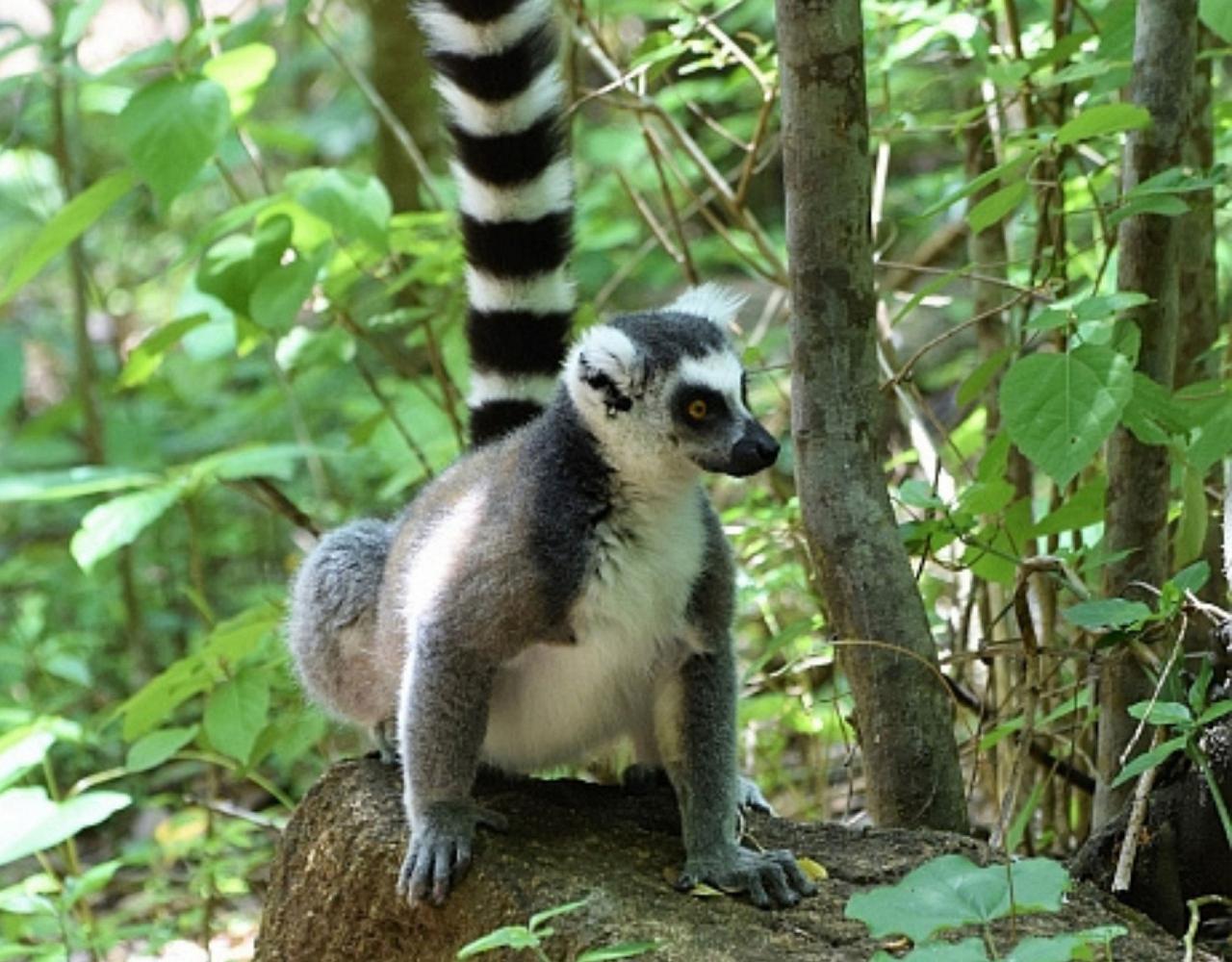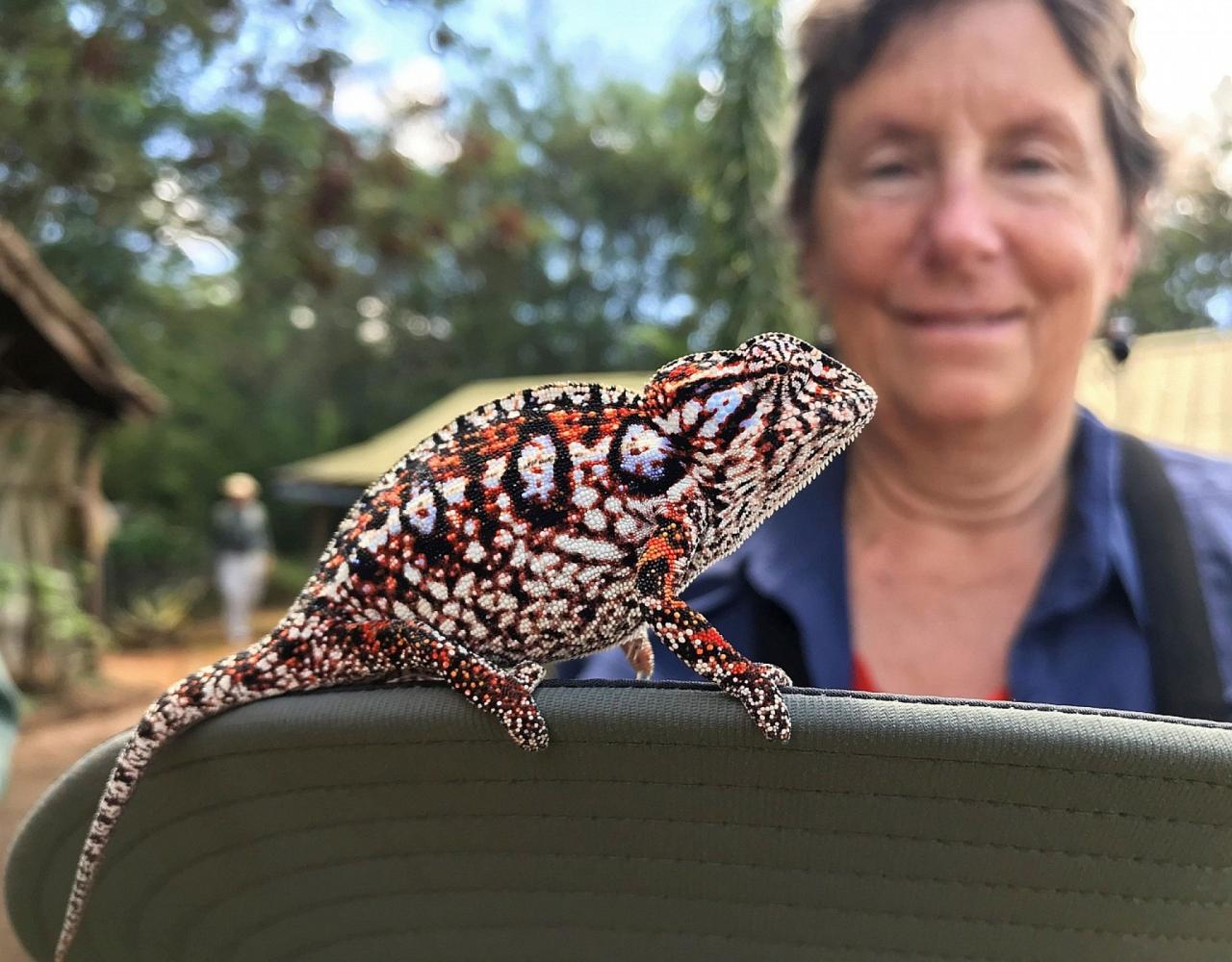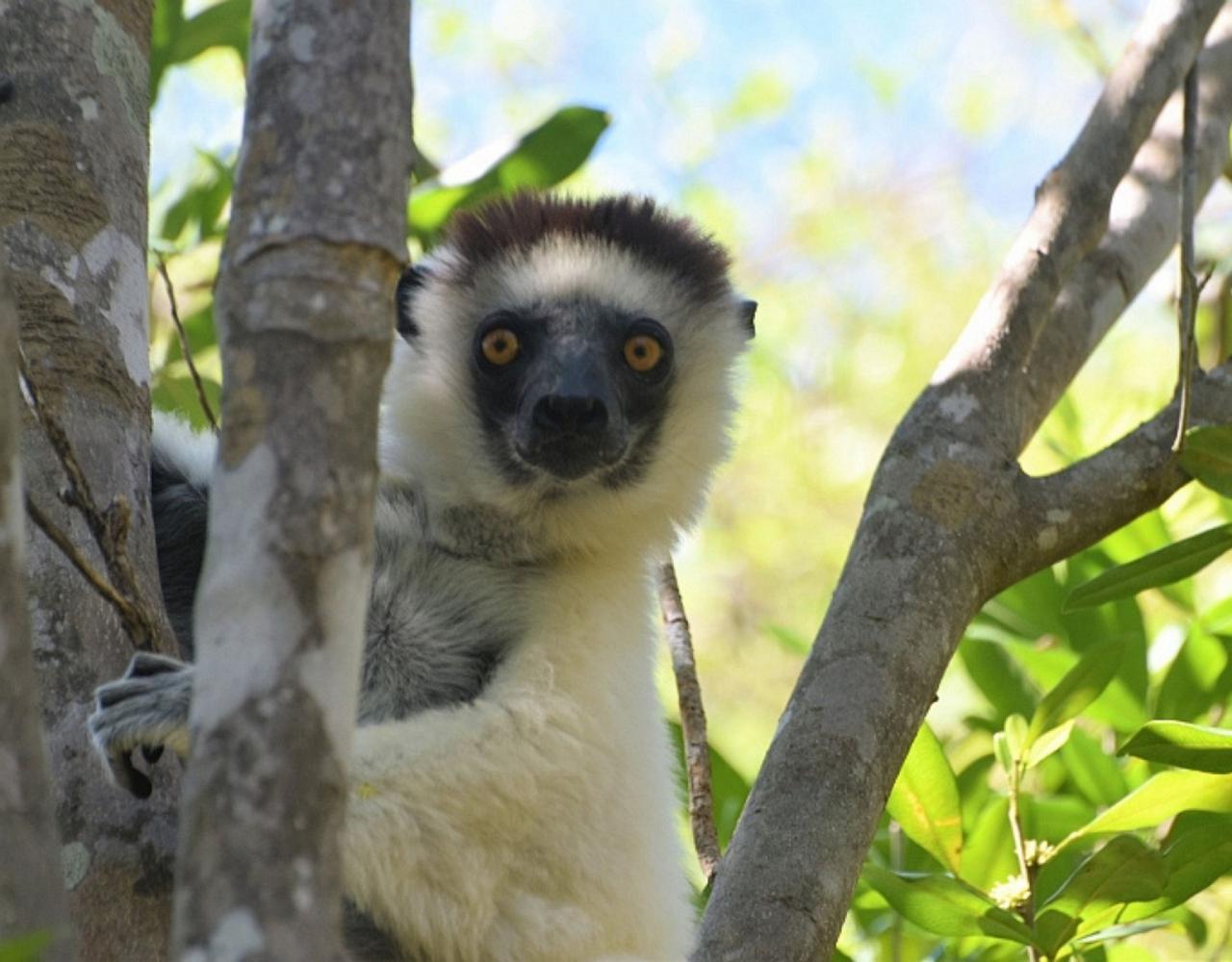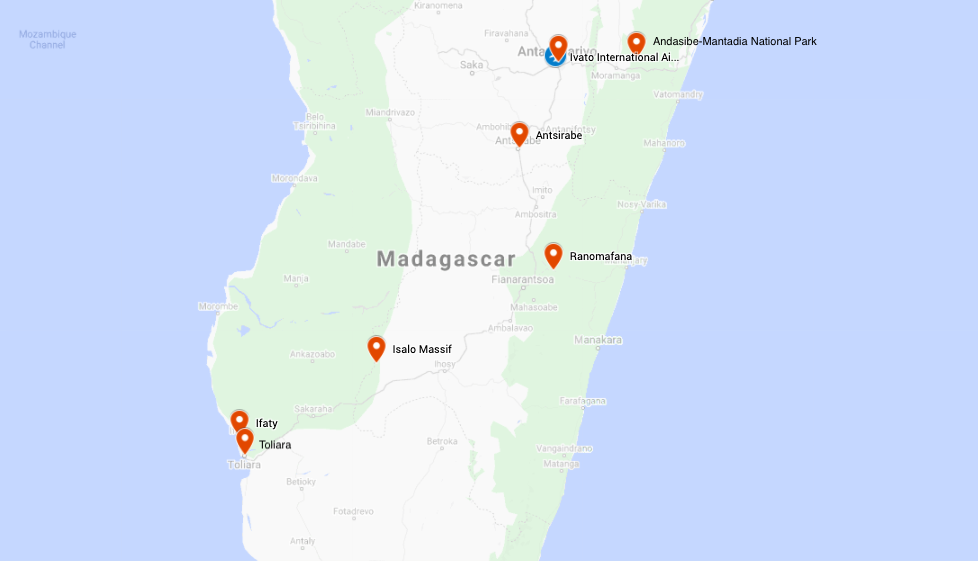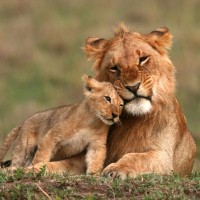- Overview
- Full Itinerary
- Photo Gallery
- Costing
- Travel Details
- Trip Reports
- Guide
- Map
- Know Before You Go
- Other Trips You May Like
Isolated from any continental landmass since the Cretaceous period, Madagascar has drifted through the Indian Ocean, following its own evolutionary course, having only five major terrestrial animal colonization events since the time of the dinosaurs.
The result? An island where every land mammal is endemic, as are nearly half the bird species. Reptiles are well represented as well, like chameleons, and day and leaf-tailed geckos. The uniqueness of this island’s fauna makes it one of the world’s great destinations for the birdwatcher and naturalist, alike.
This Naturalist Journeys tour features both birds and mammals. We focus on Madagascar’s most iconic and charismatic bird species (we hope to see over 95% of the endemics), as well as the Island's other oddities, like endearing lemurs and strikingly bizarre chameleons.
We also focus on the Island’s geology and geography with resulting various habitats – from the spiny forests of Ifaty with its towering baobabs and other-worldly Didierea octopus trees, to the verdant rainforests of Andasibe-Mantadia National Park.
- “Madagascar is magical...it is still developing, which can make it challenging but has so much to offer that you cannot find anywhere else in the world that it is totally worth any inconveniences.” — 2023 Traveler
- “Amazing, adventurous and enlightening…Loved seeing 11 different lemurs, especially seeing and hearing the Indri!” — 2023 Traveler
- “I really enjoyed seeing the lemurs (of course) and the different areas of Madagascar, as well as the endemic birds, chameleons, and geckos. More active than some other birding trips, but it was fun. All of the accommodations were very nice.” — 2023 Traveler
Tour Highlights
- Discover Andasibe-Mantadia National Park in search of the world’s largest lemur, the Indri, along with a long list of avian jewels, from Rufous-headed Ground-Roller to Madagascar Blue Pigeon
- Explore Ranomafana to search for the rare Yellow-bellied Sunbird-Asity and quirky Brown Mesite, and up to 12 lemur species, including Milne-Edwards’ Sifaka
- Travel to Zombitse National Park and La Table for two very range-restricted, recently discovered bird species: Appert’s Tetraka (Greenbul) and Rufous-shouldered Vanga (the late Phoebe Snetsinger’s last bird)
- Walk through the “spiny desert” of Ifaty, with its bizarre baobabs and euphorbias, in search of Long-tailed Ground-Roller and Subdesert Mesite
- Journey to the unspoiled islet of Nosy Ve to experience a breeding colony of Red-tailed Tropicbird, protected by generations of locals
Trip Itinerary
Itineraries are guidelines; variations in itinerary may occur to account for weather, road conditions, closures, etc. and to maximize your experience.
Mon., Nov. 3 Early Arrivals in Antananarivo
We encourage you to arrive a day before the official start of the trip to rest up after a very long journey. If you choose to arrive today, we can make hotel arrangements for you. There are no activites or meals planned for today.
Tues., Nov. 4 Arrivals | Lac Alarobia
Welcome to Madagascar! Our journey begins in Antananarivo, the capital city of Madagascar. Lying at almost 4,200 feet above sea level in the middle of the country, the city sits atop a 2-mile long rocky ridge that overlooks extensive terraced rice paddies just west of the city.
“Tana,” as it is colloquially known, originally served as the capital for the indigenous people of the island until its occupation by the French in the first half of the 20th Century. Years of colonization and immigration from other parts of the world have created a city with an eclectic mix of indigenous Malagasy, South Asian, and French elements.
When you arrive in the airport’s arrival hall after picking up your luggage and passing through customs, look for someone to meet you with a sign showing your name. This is a driver from the hotel who handles the transfer.
Today we have an optional field trip to Lac Alarobia. Here we can hope to see Madagascar Pond Heron, Comb Duck, Hottentot Teal, Little Grebe, Madagascar Kingfisher, dragonflies, butterflies, and skulking day geckos.
This evening over dinner our guide answers any questions and lets us know the next morning’s breakfast and departure time.
Accommodations in Tana (D)
Wed., Nov. 5 & Thurs., Nov. 6 Flight to Toliara | Bay of Augustin | Anakao | Nosy Ve
We meet for a briefing over breakfast. We fly this morning to the seaside town of Toliara and settle in at our lodge. Arid hillsides surrounding the Bay of Augustin are home to Madagascar’s most recently described endemic, Red-shouldered Vanga, as well as the scarce and range-restricted Verreaux’s Coua. Madagascar Sandgrouse often frequent area drinking holes.
Our two days in Toliara are spent exploring! We also board a boat across the Bay of Augustin to Anakao and Nosy Ve. Please note that this excursion cannot be guaranteed, as it is subject to weather conditions.
In the coastal vegetation near Anakao, our goal is to see Littoral Rock-Thrush. We then make the very short boat trip to the uninhabited islet of Nosy Ve where we enjoy splendidly close views of Red-tailed Tropicbird as they hover overhead. This unspoiled islet with long white beaches and aquamarine waters, also hosts roosts of resting seabirds. We scan for Lesser Crested Tern, White-fronted Plover, and Crab-Plover. Optional snorkeling can be arranged in advance.
Accommodations at Toliara (B,L,D)
Fri., Nov. 7 Ifaty | Toliara | St. Augustin Bay
The “Spiny Desert,” an ecologically diverse wonderland, is dominated by a completely foreign association of plant species. We carefully wind our way among the Didierea, avoiding the sharp spines, while trying to find various specialized, endemic species. The stars of this ecosystem are Long-tailed Ground-Roller and Subdesert Mesite, charismatic members of two different endemic bird families. Four species of vangas, including the spectacular Sickle-billed can also be found. The elusive Banded Kestrel is a good bonus!
Mid-day, when temperatures soar, we take a welcome break (and perhaps a refreshing dip in the ocean!). In the afternoon, we drive half an hour down the coast to the seaside town of Toliara and settle in at our lodge. Arid hillsides surrounding the Bay of Augustin are home to Madagascar’s most recently described endemic, Red-shouldered Vanga, as well as the scarce and range-restricted Verreaux’s Coua. Madagascar Sandgrouse often frequent area drinking holes.
Accommodations at Ifaty (B,L,D)
Sat., Nov. 8 Toliara | Anakao & Nosy Ve
If we have time this morning, we search again for Madagascar Sandgrouse. Afterwards, we board a boat across the Bay of Augustin to Anakao and Nosy Ve. Please note that this excursion cannot be guaranteed, as it is subject to weather conditions.
In the coastal vegetation near Anakao, our target is Littoral Rock-Thrush. We then make the very short boat trip to the uninhabited islet of Nosy Ve where we enjoy splendidly close views of Red-tailed Tropicbird as they hover overhead. This unspoiled islet with long white beaches and aquamarine waters, also hosts roosts of resting seabirds. We scan for Lesser Crested Tern, White-fronted Plover, and Crab-Plover. Optional snorkeling can be arranged in advance.
Accommodations at Ifaty (B,L,D)
Sun., Nov. 9 & Mon., Nov. 10 Two Days Birding Isalo
This morning we continue to Anjaha and Isalo, where we spend the remainder of today and tomorrow exploring.
En route, we explore Zombitse National Park, which protects tall deciduous forests and savannas, and their wildlife. Cuckoo-Roller, more closely related to falcons than either cuckoos or rollers, regularly displays over the canopy here. Males engage in apping displays and loops accompanied by shrieking whistles.
These forests are also home to Appert’s Tetraka (Greenbul), a highly endangered species restricted to just a handful of forest patches. Giant Coua, Coquerel's Coua, and Rufous Vanga are a few of the other species we may encounter here in this special transition zone between the south’s flora and the western deciduous forest.
The sacred forest of Anjaha protects a population of Ring-tailed Lemur. These social, iconic, and charismatic lemurs may offer splendid photo opportunities.
Our drive towards Isalo is a spectacularly scenic. We search for the elegant Madagascar Harrier along the way on a beautiful grassland plateau, where we might also spot a few species of endemic ground orchid. The Isalo Massif itself is a landscape covered in golden grasslands with rugged sandstone outcrops with hints of silver and green. Set against the deep blue sky, this magnificent landscape is reminiscent of a John Wayne Western.
Fascinating birds here include Madagascar Partridge, Torotoroka Scops-Owl, and Benson's Rock-Thrush.
Accommodations surrounded by the spectacular mountains of the Isalo Massif (B,L,D)
Tues., Nov. 11 – Thurs., Nov. 13 Ranomafana National Park
Madagascar’s government established Ranomafana National Park in 1991 to protect one of the largest remaining rainforest patches in eastern Madagascar. In 2007, the park became a UNESCO World Heritage Site. This superb tract of forest, situated at a slightly higher elevation than Mantadia National Park, boasts 161-square miles of mid-altitude rainforest and higher altitude montane forest. Small streams cascade through the eternally green park, draining into the Namorana River. This river divides the park and serves as a source of electricity for the area.
This park is of special interest to primatologists: a new species of lemur, the Golden Bamboo, was discovered here in 1986. It is also one of the best places to find one of the world’s rarest primate species, the Greater Bamboo Lemur. A hotspot for lemur diversity, Ranomafana boasts 12 species, including the superb Milne-Edwards’ Sifaka. We explore the excellent network of paths through the forests and dense stands of giant bamboo for these and other mammal species. If we are lucky, we may see Malagasy Striped Civet and Ring-tailed Mongoose.
We also find a host of new bird species in these foothill and montane rainforests home to most of Madagascar’s avian endemics, including: Pitta-like Ground Roller, White-throated Oxylabes, Crossley’s Vanga, and Pollen’s Vanga. We also search for the more retiring Madagascar Wood-Rail, Brown Mesite, and Henst’s Goshawk.
Vohiparara, a nearby cloud forest site, is our focus one morning. This emerald forest of mist and moss is the best site in the world to find the brilliantly colored Yellow-bellied Sunbird-Asity. Other excellent species here include Rufous-headed Ground-Roller, Brown Emutail, and Velvet Asity. Small patches of marsh may hold Gray Emutail and Madagascar Snipe. A nearby river holds possible Madagascar Pratincole.
Accommodations at Ranomafana (B,L,D)
Fri., Nov. 14 Antsirabe
Today is mostly a travel day. We pass colorful rice paddies on winding roads through the countryside until we arrive at the picturesque city of Antsirabe, the third largest city in Madagascar, known for its cool climate, thermal bath center, and plentiful rickshaw taxis.
Accommodations at Antsirabe (B,L,D)
Sat., Nov. 15 – Mon., Nov. 17 Andasibe-Mantadia National Park
This morning we head to the famous Andasibe-Mantadia National Park, our base for the next three nights. This park, established in 1989, protects a spectacular 155-square kilometer rainforest that is home to 11 species of lemurs, including the child-sized Indri. If we are lucky, we are greeted by the Indri’s calls long before we see them — they can be heard from up to a mile away!
This wilderness is an incredibly lush region that records over 200 days of rain a year and home of the iconic Indri Lemur. Also known as Anamalazaotra Special Reserve, or by the French name Perinet, Andasibe was formerly part of a tract of contiguous forest with the larger Mantadia National Park. Deforestation has since fragmented these protected areas. We visit the two now divided preserves that protect one of Madagascar’s most important primary rainforest areas.
We explore the area’s various trails with local guides, walking along streamsides and in ridge forest, as well as a small lake. This rainforest is Madagascar’s most biodiverse ecosystem. As a result, the list of birds we can see is long; highlights may include Madagascar Flufftail, Madagascar Blue Pigeon, Dark Newtonia, Nuthatch Vanga, and Madagascar Pygmy-Kingfisher. We may also be fortunate enough to encounter Collared Nightjar roosting almost imperceptibly on the forest ?oor, a species so poorly known that its vocalizations are still unknown. Another nocturnal species that we may see is Madagascar Long-eared Owl, the largest owl species on the island.
Mantadia is also the best place in the world for Ground-Rollers. With patience, visitors may find four secretive rainforest species in a single morning: Pitta-like, Scaly, Rufous-headed, and Short-legged Ground-Roller. We may also find Lesser Vasa Parrot and three species of Coua: Red-breasted, Blue, and Red-fronted.
Despite a long list of incredible birds, one of the top experiences here is the Indri’s morning calls as they echo through the misty forests. These plaintive wails from the world’s largest lemur are reminiscent of whale sounds! We listen and hopefully observe them at Andasibe, along with the iconic Diademed Sifaka and Black-and-White Ruffed, Greater Dwarf, Brown, and Gray Bamboo Lemurs.
The eastern rainforest is also an excellent place to sample some of Madagascar’s varied and colorful chameleons, day geckos, and leaf-tailed geckos. We search for these while birding during the day and we will have another opportunity to spot some of Madagascar’s unusual reptiles and amphibians on a night walk.
Accommodations in Andasibe-Mantadia National Park (B,L,D)
Tues., Nov. 18 Drive to Tana | Departures
Our tour ends today. Today, we drive back to Tana, a 3-4 hour drive, which we make after some local birding. We plan to be back by 4:00 PM to catch your international flights home this evening from 7:00 PM onward, or we can help you make arrangements to stay on and explore on your own. Just ask! (B)
Cost of the Journey
The cost of the journey is per person, based on occupancy: $8890 DBL / $9515 SGL.
The cost includes: accommodations for 14 nights, all meals as indicated in the itinerary, a Naturalist Journeys host (with at least 8 participants) and a Birding Africa tour-leader. It includes local guides, bottled water in the bus, entry fees at parks and reserves and activities as indicated on the itinerary, as well as tips for lodge and local guides and services. A bird checklist is provided on arrival.
The cost does not include: transportation from your home city to Antananarivo, optional activities, or items of a personal nature such as laundry, telephone charges, gratuities for guides, lodges and drivers, or beverages from the bar. Cost of the tour does not include tips for your full tour guides (2) and main tour driver; we will provide guidance on appropriate tipping amounts in your pre-departure materials.
Travel Details
Please plan to make air travel plans only after the minimum group size has been met. We will send you a confirmation email as soon as the trip has been confirmed.
Arrival and Departure Airport: Ivato International Airport (TNR) in Antananarivo (known as ‘Tana), Madagascar
Arrival Details: We encourage you to arrive a day early, on November 3, to rest up from your travels. Please plan flights to arrive no later than 5:00 PM on November 4, in order to join the group for dinner and orientation.
Departure Details: Plan flights to depart November 18, after 7:00 PM
We should reach the airport by 4:00 PM on the departure day.
Travel Tips: This is a LONG way to fly, often with several stops, so coming in a day early to rest and relax is a great idea if you have the time to do so. We can book you an early night at our first night hotel, the San Cristobal Boutique Hotel, which is not far from the airport and in a quieter residential area.
Entry Requirements: See "Essential Information" section under the "Know Before You Go” tab.
Items of Note
Route
The exact sequence of events and locations on our itinerary may vary with Air Madagascar’s flight schedules. Sometimes we run this tour in reverse order, but the main areas we visit remain the same.
Accommodations
Our hotels are good by African standards! This isn't a budget trip and we make an extra effort to stay in comfortable hand-picked accommodations, upmarket where possible, and as close as possible to the best birding areas. Rooms have private facilities with hot showers, although the supply of hot water in Madagascar can be intermittent!
Meals
Meals are Western-style, with a hint of French and Malagasy influence. Zebu, the local beef, features predominantly on the menu. Seafood is popular at the coast. Please advise if you are vegetarian and what foods you enjoy, so that we can accommodate you. Water is not safe to drink, so we supply free bottled water in the vehicle, which you can take to your room in the evening for drinking and brushing teeth.
Pace of the Tour, Transport & Timing
The tour is timed to coincide with the breeding season. The days are cool to warm in the highlands and hot in the dry forest. To find birds and lemurs and cope with heat, we need to have early starts and a lot of time in the field. Transport for short distances is by minibus or four-wheel-drive vehicles, and for longer drives by a larger coaster bus, which regularly allows for approximately one and a half seats per person.
This tour requires a moderate to good degree of fitness. Most walks start at the coolest times of the day at a slow to fair pace. Most walks are generally relatively flat, with small ups and downs on many trails. There are two exceptions: at Ranomafana and Andasibe where the trails can be steep and the pace faster. These walks can either be skipped or taken slowly with a private trail guide.
Browse below for trip reports and species lists from past versions of this and other tours from this destination.
Madagascar
- November 2016
- November 2017
- December 2018
- November 2022
- November 2023
- November 2024
- November 2025
-
David Jaffe

David Jaffe is an engaging naturalist inspiring people through his curiosity to develop meaningful connections with our home planet. He has been an avid birder since volunteering with the National Audubon Society in 1991. Over his 30+ year career in the outdoor industry, he has gained experience as a guide throughout the United States and on all seven continents. He is a certified National Geographic Photography instructor and works as a naturalist and lecturer on expedition ships. He helped establish a marine protected area off the coast of Madagascar and assisted with bird research projects in the United States, Canada and South America. He has led backcountry trips in Denali National Park and gained great insights while working as a Park Ranger in Yosemite and Sequoia National Parks. He is a passionate birder with a keen interest in geology, botany, and the intricacies of natural history. He loves this work and infuses every tour with his enthusiasm, knowledge and care.
Other trips with David Jaffe
-
 Trinidad & Tobago: Incredible Birds & WildlifeJanuary 23 - February 1, 2026
Trinidad & Tobago: Incredible Birds & WildlifeJanuary 23 - February 1, 2026 -
 Costa Rica: Monteverde & More!March 18 - 28, 2026, w/La Selva/Sarapiqui extension
Costa Rica: Monteverde & More!March 18 - 28, 2026, w/La Selva/Sarapiqui extension -
 Southeast Arizona FULL - Check out Arizona Monsoon Madness!May 2 - 11, 2026
Southeast Arizona FULL - Check out Arizona Monsoon Madness!May 2 - 11, 2026 -
 Birding Canyon CountryMay 17 - 25, 2026
Birding Canyon CountryMay 17 - 25, 2026 -
 Oregon: Mountain Peaks to Pacific Beaches July 25 - August 1, 2026
Oregon: Mountain Peaks to Pacific Beaches July 25 - August 1, 2026 -
 Arizona Monsoon Madness: Birding & Nature in a Season of Wonder!August 4 - 11, 2026
Arizona Monsoon Madness: Birding & Nature in a Season of Wonder!August 4 - 11, 2026 -
 Madagascar: 8th Continent!November 4 - 18, 2026
Madagascar: 8th Continent!November 4 - 18, 2026 -
 Classic Alaska: Birding & Wildlife: Anchorage, Nome, Seward & Kenai Fjords Sold as a private tour.June 8 - 17, 2027
Classic Alaska: Birding & Wildlife: Anchorage, Nome, Seward & Kenai Fjords Sold as a private tour.June 8 - 17, 2027
-
Essential Information +
Pace & Protocols +
Packing List +
Suggested Reading List +
Useful Links +
Photo credits: Banner: Ring-tailed Lemur by Bob Ashley; Chameleon by Bob Ashley; Green Sunbird, Naturalist Journeys Stock; Baobab Trees, Naturalist Journeys Stock; Moth, Naturalist Journeys Stock; Chameleon by Bob Ashley; Diademed Sifaka by Peg Abbott; Rickshaw Ride by Mike Anderson, Red Fody, Bob Behrstock; Andasibe NP Sign, Peg Abbott; Indri Andasibe NP, Peg Abbott; Ranomafana Scene, Carlos Sanchez; Ifaty Landscape, Bob Rodrigues; Group Photo, Carlos Sanchez; Long-tailed Ground-Roller, Bob Rodrigues; Verraux's Sifaka, Carlos Sanchez, Subdesert Mesite, Carlos Sanchez; Madagascar Iguana, Carlos Sanchez; Pita-like Ground-Roller, Carlos Sanchez



